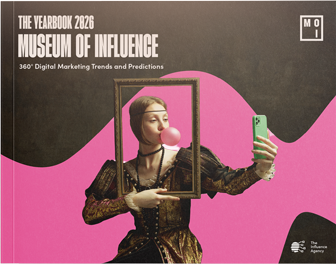The marketing landscape is in a constant state of evolution. Each wave of technology disrupts the old way of doing things, reshaping how brands reach audiences and redefining what’s possible. This journey traces the seismic shifts from the age of print to today’s AI-driven marketing frontier.
The golden age of print: Dominance before television
From the late 1800s through the early 1900s, newspapers and magazines ruled the advertising world. Print media relied on visual storytelling, bold headlines, and persuasive copy to reach mass audiences. For decades, it shaped how products and brands were discovered and purchased.
Print was slow, deliberate, and tangible, the ads you could hold in your hands. But by the mid-20th century, radio and a glowing new box in the living room began pulling attention away.
Television revolution: The rise of moving ads
By the end of the 1950s, television had entered most households, ushering in a golden era of broadcast advertising. Television combined sight, sound, and motion to create shared cultural moments. Celebrity endorsements, catchy jingles, and product placements became essential tools for capturing attention.
For the first time, brands could tell emotional, immersive stories to millions at once. But just as TV cemented its power, another disruptor was waiting in the wings.
Search engines and the digital era emergence
In the late 1990s and early 2000s, the internet transformed how consumers found information. Search engines like Google made it possible for people to actively seek solutions rather than passively consume ads. Google AdWords PPC and SEO allowed for precise, intent-based targeting.
Marketers now had data to measure every click, and content marketing became a cornerstone of trust-building and brand discovery. The audience wasn’t just watching anymore; they were searching.
Social media explosion: Changing the rules, again
By the 2010s, social media platforms like Facebook, Instagram, and Twitter reshaped digital marketing again. Algorithms decided what content audiences saw, real-time interaction became possible, and user-generated content blurred the lines between brands and communities.
Influencer marketing exploded, and authenticity often outperformed polished campaigns. Marketing became bite-sized, shareable, and always on. But as social feeds grew crowded, yet another disruptor emerged, one that wouldn’t just change how we communicate, but how we create.
AI disruption: Marketing's smartest frontier
Today, artificial intelligence is redefining the rules of marketing. Generative AI creates high-quality copy, images, and videos in seconds. Chatbots deliver instant customer support. Predictive analytics anticipate needs before the customer even expresses them.
AI has made one-to-one personalization at scale a reality, shifting marketing from reactive to proactive. Instead of waiting for audiences to search, brands can now meet them at the exact moment of need, across any channel.
The bigger picture
From print’s permanence to AI’s predictive power, every disruption has forced marketers to adapt, and each shift has brought both loss and opportunity. The winners have always been those who embraced the change early, reimagining their strategies for the medium that came next.
“OpenAI CEO Sam Altman has said AI will one day do 95% of what marketers currently rely on agencies, strategists, and creatives for. I don’t buy it,” says Emily Baillie, Marketing & AI Strategist & Trainer at Compass Content. “Audiences still crave authenticity, creativity, and human connection, things no algorithm can fully replicate. The marketers who will be most successful in this new era won’t stand out because of where their degree is from or what their résumé looks like.”
It’ll come down to how fast they can learn, she says.
“Adapt and apply new tools responsibly. I see this every day when training marketing teams across North America: the ones who lean into learning are the ones who win. The future of marketing, like many other industries, is AI and humans working alongside one another.”
AI may be today’s disruptor, but it’s also tomorrow’s baseline. The real question isn’t if it will change your marketing, it’s how fast you’ll adapt when it does.

